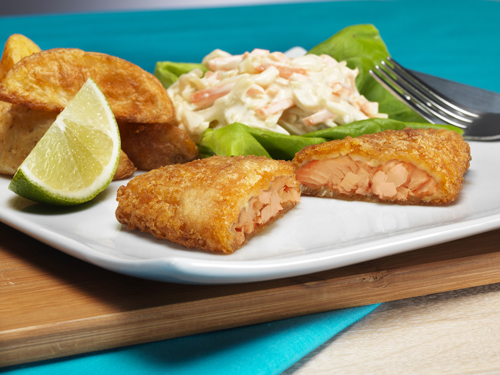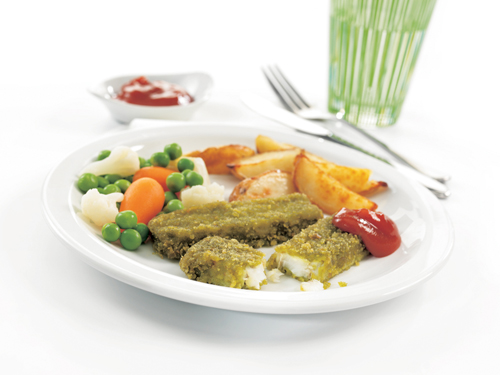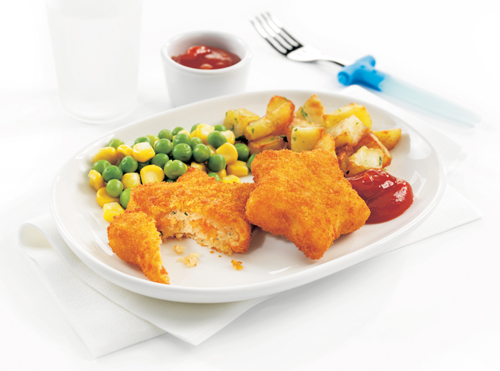How to get fish back on the menu in schools
School cooks are learning imaginative ways to hook pupils on fish. Richard McComb reports
More than 30,000 pupils sit down for school dinners in the London borough of Newham each day. If fish fingers are on the menu, up to 80% of the young diners will select the British meal staple for their main course.
Take the same white fish and serve it plain, accompanied with a dill sauce, and the take-up rate drops to 20%, according to Peter Sawula, health and nutrition officer for Newham Catering and Cleaning Services.
Sawula says: "When kids think of fish, they see it as having breadcrumbs. But there is a lot more awareness among parents about healthy foods and the importance of ingredients. The message is starting to get through."
The state of school dinners sparked a public outcry in 2005 thanks to celebrity chef Jamie Oliver, and there has been steady progress in improving nutritional standards since those dark days. The latest move saw the introduction of a new set of food standards that became mandatory in maintained schools, new academies and free schools from January 2015.
Oily fish, such as fresh, tinned or frozen salmon, sardines, pilchards, mackerel or herring, has to be served at least once every three weeks. The regulations might not be as robust as the Department of Health's general population advice (two portions of fish each week, including oily fish), but they are said to reflect the balance schools have to strike in enticing, rather than alienating, young fish consumers.
School cooks have their work cut out. A national diet survey in 2014 revealed as few as 8% of children eat oily fish, a foodstuff hailed for containing omega-3 fatty acids linked to maintaining a healthy heart.
A lunch service at Bygrove Primary School, Tower Hamlets
The battle to boost fish consumption is being waged across the country including Newham, where Sawula is responsible for setting menus for the borough's 65 primary and 10 secondary schools.
Sawula says: "Fish options are particularly important and appear daily on our primary menus. We offer a wide variety of options to keep the children interested in eating fish regularly. We have everything from salmon and cod fillets with dill or cheese sauce to fish bakes, tuna jacket potatoes, wraps and even fish curry."
Schools are encouraged to hold taster sessions, with fun cartoon-style characters, to encourage children to step outside their dietary comfort zone. Working with JJ Food Service, Newham ensures the majority of its fish is accredited by the Marine Stewardship Council (MSC) and hopes it will be 100% MSC compliant in the near future.
This is welcomed progress for Susan Jebb, project manager of the School Food Plan Standards Panel, chaired by Leon co-founder Henry Dimbleby, which drew up the new food regulations.
Jebb told The Caterer that most people, including children, eat "far, far, far less fish than recommended". Fish and shellfish are great sources of protein and are rich in many vitamins and minerals such as iron and all the B vitamins except folate.
Jebb, professor of diet and population health at Nuffield Department of Primary Care Health Sciences, Oxford University, believes schools have an important role to play in encouraging children to eat fish, particularly among pupils who come from families where fish consumption is rare. Canteen peer pressure and positive role models can be highly effective in promoting healthy eating.
Jebb says: "People learn to like things by exposure and repeated exposure. Many parents say their children will eat things at schools that they find difficult to persuade them to eat at home.
"It's a good opportunity to boost children's fish intake and encourage them to lay down the habits of fish eating, which will last them into later life."
But how do school chefs make this tasty and healthy food group more appealing to young fish sceptics? It was with this challenge in mind that The Children's Food Trust recently published a guide, Fish Recipes and Tips.
MSC salmon mini fillets
Dr Patricia Mucavele, head of nutrition at the Children's Food Trust, concedes cooks and caterers struggle to get children to eat oily fish, which can have a stronger taste. The trust suggests combining a small amount of oily fish, such as salmon or mackerel, with white fish in a pie or a casserole, for example.
Mucavele says it is also important to reflect popular eating trends, particularly when it comes to secondary pupils. The 'grab-and-go' concept has proved a hit and Fish Recipes and Tips features a recipe for pea and mint-topped pollock with wholemeal pitta bread, tomato salsa and natural yoghurt. The dish is on-trend for casual dining and ticks the boxes for protein and carbohydrate content to sustain teenage energy levels.
More than 3,500 schools in the UK now have MSC supplies, ensuring traceability and sustainability - and school inspection approval. An MSC spokesman says: "From September this year, Ofsted inspectors will be expected to put a greater emphasis on school food than ever before. Schools that have MSC certification will be able to use the specially designed resources available from the MSC to support in this aspect, helping caterers and teachers to educate pupils about certified fish and marine sustainability."
Mushy pea fish fingers
The MSC provides free education resources, including fun educational posters, assembly plans and teachers packs, to help children learn about fish species and sustainability.
There are eight MSC-certified contract caterers and 12 UK suppliers and brands carrying MSC certification that focus on education. M&J Seafood's dishes include MSC mushy pea fish fingers, MSC sweet potato starfish and MSC popcorn fish, the colours and presentation of which are designed to capture children's interest.
Sweet potato starfish
Nicole Pisani
Nicole Pisani is the school cook who banished fish fingers. "I didn't ban them so much as stop ordering them," says Pisani, former head chef at Yotam Ottolenghi's Nopi in Soho.
Today, she devises menus and runs the kitchen at Gayhurst Community School in Hackney. Giving frozen fish fingers the boot was a controversial decision and the chef faced her critics at heated school council meetings.
"I keep saying there should be more chefs in schools. There is no point in doing the job just to fry fish fingers in a fryer," says Pisani.
The chef struck a deal with her 600 regular customers and now makes pollock fish fingers coated with oats and panko. A single, chunky finger might be served with peas and egg ribbons - a finely chopped omelette that the diners love.
Alternative fish dishes, on rotation on Fridays, include hake or pollock skewers, which are rolled in polenta, and salmon and samphire, cooked in a kombu (seaweed) stock. Accompaniments include Japanese brown rice with vegetables, tandoori carrot or homemade baked beans.
Pisani says there are no steadfast rules on what the children like. "I have got to learn that they love umami. They love soy sauce, pesto, Parmesan. They like edible flowers. Some things are really off the radar and some things that you think would be child-friendly they don't like. You can't have a formula."
Pisani has a brigade of eight, including five chefs. Her plan is for all serving staff to be trained as cooks to boost job satisfaction and rota flexibility.
Six months into the project, she is both exhilarated and, one suspects, battle-scarred.
Pisani says: "I have had children crying and complaining about the food. It is harder than adult customers. They come in the line grumbling because it is fresh fish for lunch and not fish fingers. But the teachers are brilliant. They tell the children they should see what they eat at other schools."
Tower Hamlets LEA
Tower Hamlets introduced new MSC-certified salmon products on menus at 110 schools in East London. MSC salmon fillets in vinegar-infused tempura batter and piri piri MSC salmon fillets, from Crown Foods and Feldt's Seafood respectively, were launched at Bygrove Primary School in April.
Crown Foods' mascot "Suzy Salmon" encouraged pupils to try sustainable fishy tasters. The MSC provided its Fish and Kids materials in the dining hall and handed out teaching resources and activity sheets.
Stefanie Siebels, of the MSC, says: "It is great to see Tower Hamlets responding to a general shift towards using more plain fish products as a healthier option for children."
Steve Logan, quality assurance and performance development officer for Tower Hamlets, says: "We want to get pupils eating more oily fish, expand our range of sustainable fish available to our school cooks and introduce delicious salmon fillet recipes."
James Rasor, product and quality assurance director at Crown Foods, says children's feedback on oily fish suggests it can be unappetising for younger palates due to its strong taste.
"To combat this, we launched MSC salmon fillets in vinegar-infused tempura batter and MSC tempura battered salmon and sweet potato fishcake products," says Rasor.
"Both high in omega 3, we have paired prime MSC-certified salmon fillet with innovative flavours to provide flavours that are attractive to a younger audience, while still offering the wealth of natural properties found in oily fish."
White fish
White fish is low in fat and makes a healthy alternative to red or processed meat, which tends to be higher in fat, especially saturated fat.
White fish also contains omega 3 fatty acids, but at much lower levels than oily fish.
Unlike oily fish, most white fish does not carry a restriction on the number of portions that can be eaten each week. (Exceptions are sea bream, sea bass, turbot, halibut and rock salmon, which may contain similar levels of certain pollutants as oily fish.)
Non-oily fish includes haddock, plaice, coley, cod, canned tuna, skate and hake.
Oily fish
Oily fish contains long-chain omega 3 fatty acids which may help prevent heart disease.
It is a good source of vitamin D, although our bodies make most of it from sunlight. Vitamin D is important to regulate calcium and phosphate, which helps to keep bones healthy.
Some oily fish (whitebait, canned sardines, pilchards and canned salmon) contain bones you can eat - which help keep our bones strong because they are good sources of calcium and phosphorus.
Tuna only counts as an oily fish when it is fresh or frozen - the omega 3 fatty acids are removed during the canning process.















